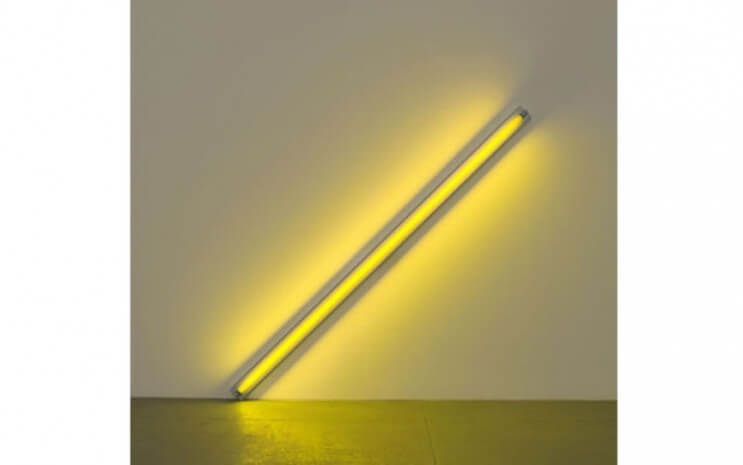
Dan Flavin and the Abstract Light Installations
An atmosphere of spirituality often accompanies abstract art. Mysticism thrives where beauty is abundant and meaning ambiguous. But some abstract artists deny that their work contains profundities, transcendental qualities or any meaning whatsoever beyond aesthetic formalities. Dan Flavin is a quintessential example of this phenomenon. One of the most influential artists of the 20th Century, Flavin broke new ground in the use of light in Modernist art. His works are beautiful and without precedent, making them ripe for creative interpretation. Their ethereal nature, glowing luminescence and even their titles invite associations with the sacred. But Flavin maintained that such associations held no merit. Insisting his art simply consisted only of light illuminating architecture, Flavin said, “One might not think of light as a matter of fact, but I do. And it is, as I said, as plain and open and direct an art as you will ever find.”
Iconic or Ironic
Flavin was raised in an Irish Catholic household in Queens, New York. As a teenager he studied to become a priest. But unmoved by the thought of a life in the church, at age 19 he joined the military with his brother. During his enlistment in Korea he began seriously studying art, and after completing his tour of duty he returned to New York where he continued studying art and worked odd jobs in museums. In 1961, after experimenting with various painting and collage styles, he created his first light-based works, a series of painted boxes that hung on the wall and were wired with light bulbs. He called these works “icons.”
The word icon referred to luminous, sacred paintings made by Russian Orthodox Christian painters in Byzantine times. Combined with his own history of being raised in a Catholic family and the five years he spent studying to become a priest, Flavin’s use of the word icon for these objects could easily imply spiritual intentions. Except that Byzantine icon paintings were painstakingly made according to exacting aesthetic standards. They incorporated expensive and rare mediums to achieve their luminous effect and they were created to grace the interiors of glorious, sacred spaces built to honor the divine. Flavin’s icons were hollow, minimal objects built from cheap materials. They used mass-produced light to achieve their luminosity and were, according to Flavin, “constructed concentrations celebrating barren rooms.” They were in every sense the opposite of their historical counterparts. So were they iconic, or was Flavin being ironic?
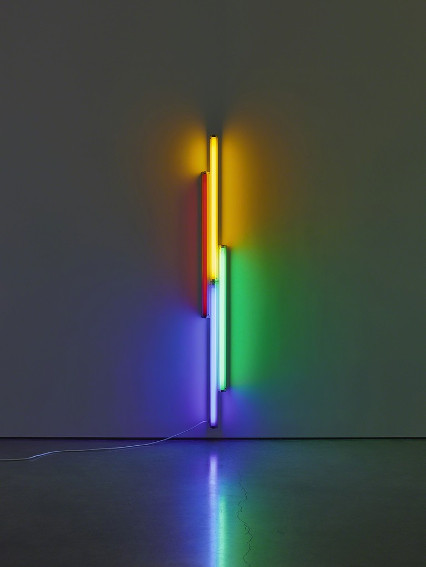
Dan Flavin - Untitled (to Véronique), 1987. Red, yellow, blue and green fluorescent light. 96 in; 243.8. cm. Waddington Custot, London
Monuments to Light
Two years after making his first icon, Flavin experienced a breakthrough. He took the leap of eliminating the painted boxes, foregoing the use of any kind of secondary aesthetic supports and opting instead to attach his lights directly to the wall. By using slightly modified, store bought fluorescent lights as objects of art he affiliated himself with movements like Arte Povera and Dadaism, because of their use of everyday materials and readymade objects, and Minimalism, because of its reliance on industrial materials and processes. Flavin dedicated his first work in this new style to the artist Constantin Brancusi whose Endless Column sculpture influenced his thinking.
Restraining himself to an austere color palette and a small range of bulb sizes, Flavin began a prolific exploration of the possibilities his new style offered. He made 50 pyramid-shaped “Monuments” dedicated to the Russian Constructivist artist Vladimir Tatlin, and created scores of untitled fluorescent compositions dedicated to other artists who influenced him, such as Alexander Calder, Robert Ryman and Jasper Johns. What was remarkable was that these compositions not only served the function of being aesthetic objects, but they also served to alter the perception of the space in which they were exhibited.
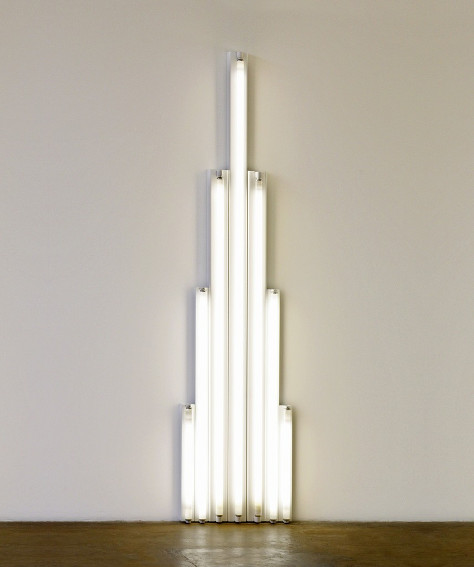
Dan Flavin - "Monument" 1 for V. Tatlin, 1964. Fluorescent light tubes (cool white). 96 1/10 × 23 1/5 in; 244 × 59 cm. "Black Sun" exhibition at Fondation Beyeler, Riehen
Corners, Barriers and Corridors
As interest in Flavin’s work increased he was given access to an expanding range of architectural spaces in which to exhibit. He capitalized on this development to explore more deeply the way his light compositions could affect the nature of architectural space. He categorized his various ideas according to the spaces they inhabited, using names like “corners,” “barriers,” and “corridors.” His “corners” inhabited the architectural space of a corner, either creating an aesthetic phenomenon in the corner itself or using the corner as a point of departure from which to affect the rest of the space. His “barriers” created artificial divisions in space, causing light to act as both the focus of and the disruptor of the viewer’s experience.
Flavin’s “corridors” used light to alter the aesthetic experience of hallways. In some cases they distorted the way hallways were perceived. In other cases the hallway seemed to act as an exhibition space for a composition of lights. And in some circumstances, the lights seemed to simply enhance the aesthetic beauty of the space.
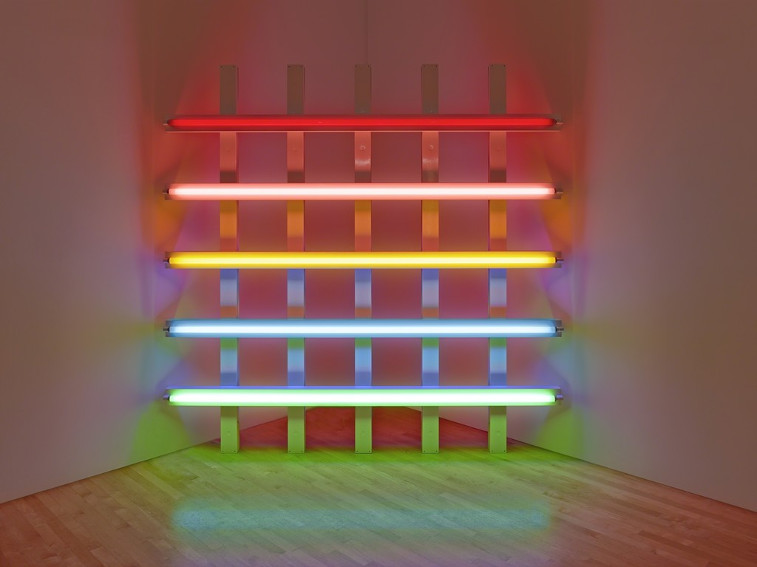
Dan Flavin - untitled (in honor of Leo at the 30th anniversary of his gallery), 1987. Red, pink, yellow, blue, and green fluorescent light. 96 × 96 in; 243.8 × 243.8 cm. San Francisco Museum of Modern Art (SFMOMA), San Francisco
Situations and Proposals
The ambiguity of Flavin’s creations led him to cease referring to them as artworks. He was aware that his light compositions constituted only one part of the experience viewers might have in the presence of the work. The entirety of the viewer experience was much larger than even he could predict. He therefore started calling his creations “situations” and “proposals,” implying that they represented only the beginning of an ongoing aesthetic process.
Some “situations” inhabited sacred places, such as churches. Others inhabited industrial spaces. Still others inhabited traditional art environments such as a museum. The full experience of a Flavin Situation depends on the light, the architecture, atmospheric conditions, as well as whatever personal factors the viewer brings into the environment based on their pre-existing relationship with that particular type of space.
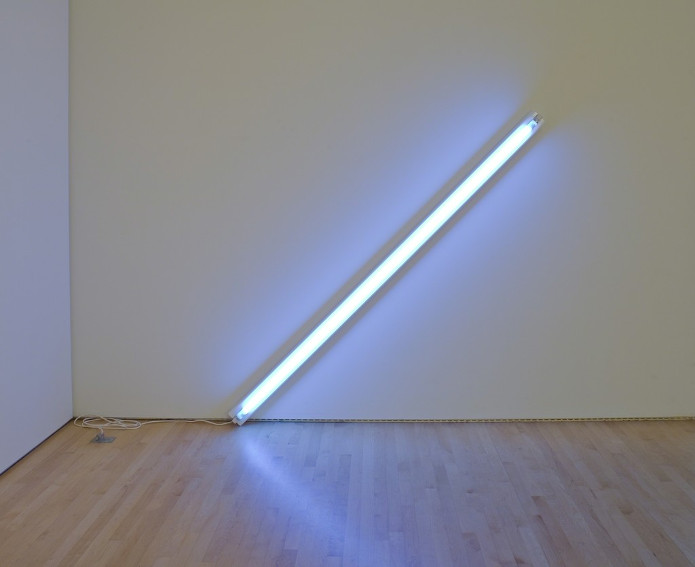
Dan Flavin - The Diagonal of May 25, 1963, 1963. Blue fluorescent light. 96 in; 243.8 cm. San Francisco Museum of Modern Art (SFMOMA), San Francisco
Shining Lights
So how do we contextualize Flavin’s work? Do its abstract qualities contain a deeper, hidden meaning beyond its formal qualities? It depends who you ask. Since Flavin’s light installations integrate so beautifully into the spaces they occupy, it is only natural that viewers react emotionally when encountering them. For most of us most of the time, a room is just a utilitarian space, illuminated not for pleasure but for functionality. When someone lights a space for beauty rather than business we call it mood lighting, because of the vivid emotional reactions it tends to inspire.
But in reference to his own insistence on his works’ lack of underlying meaning, Flavin famously coined the expression “It is what it is,” continuing, “and it ain't nothin' else...Everything is clearly, openly, plainly delivered.” Nonetheless, like children using a screwdriver rather than the intended hammer to pound in a nail, we remain tempted to re-contextualize Flavin’s art for our own purposes. Maybe it reflects a sense of entitlement. We take it as our sovereign right to objectify an artwork in whatever way works for us, regardless of the artist’s intent. Or maybe we should just call it the Interpreter’s Gaze: a gift we art viewers bestow upon ourselves that allows the value of the combination of an artwork and ourselves to add up to more than that of its individual parts.
Featured Image: Dan Flavin - The diagonal of May 25, 1963 (to Constantin Brancusi), 1963
All images used for illustrative purposes only
By Phillip Barcio






